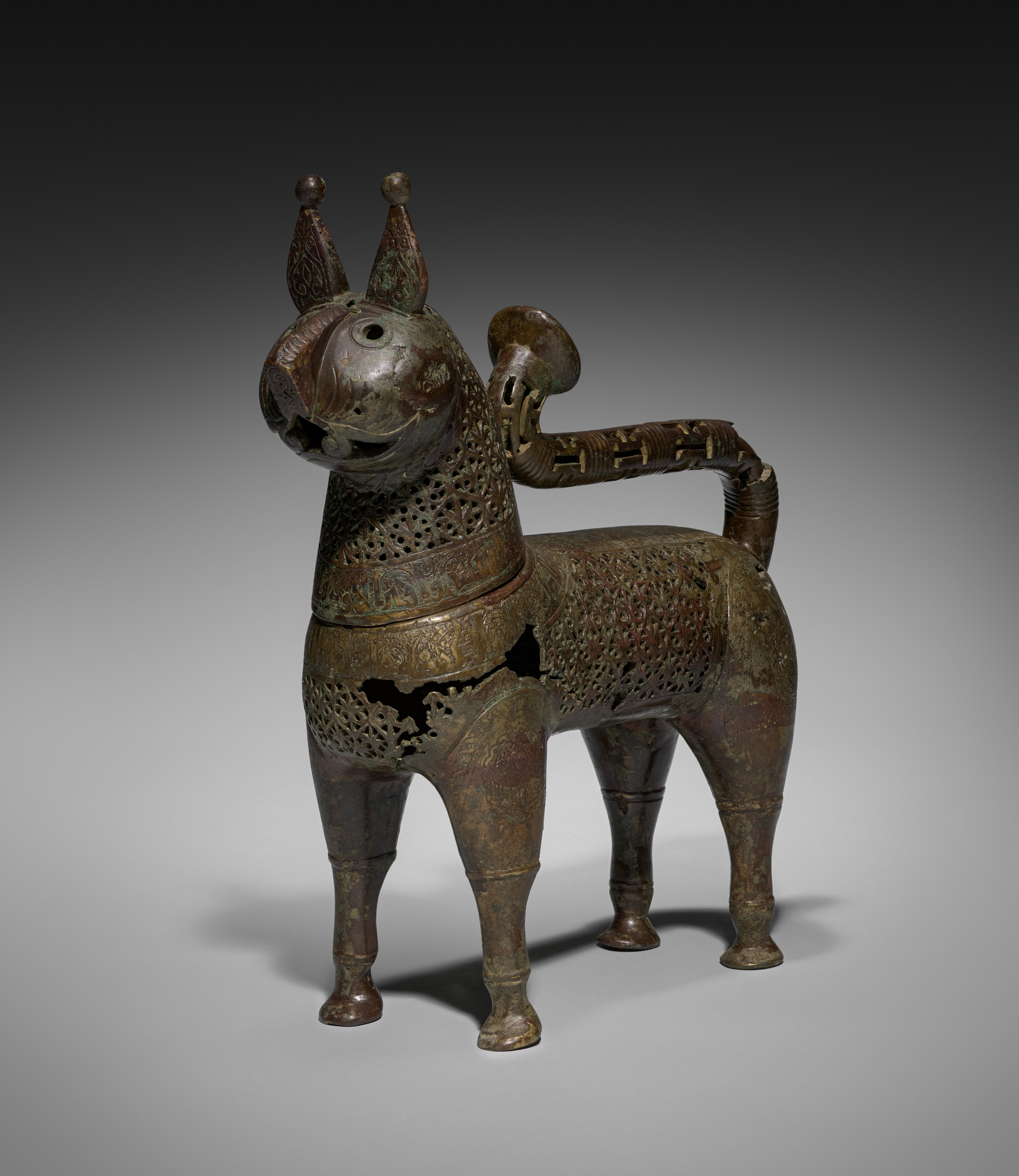The Cleveland Museum of Art
Collection Online as of April 15, 2024

Feline Incense Burner
1150–1200
(1037–1194)
Overall: 35.5 x 11 x 32.5 cm (14 x 4 5/16 x 12 13/16 in.); Head: 17.8 x 9.5 x 12.5 cm (7 x 3 3/4 x 4 15/16 in.)
John L. Severance Fund 1948.308
Location: 116 Islamic
Did You Know?
Arabic inscriptions in Kufic script against a background of scrolling arabesques run along the back and neck of the feline form.Description
In Iran during the 1000s and 1100s, vessels in the shape of animals gained popularity, especially as incense burners. Felines were favored in Persian art and this piece may represent a caracal, a type of lynx. The head of the creature was cast separately and is removable to fill its body with hot coals and incense. Qur’anic verses on the neck and spine remind worshippers to set work aside, attend prayer, and then disperse to seek God’s bounty. The diffusion of perfumed smoke through the burner’s pierced palmette design may have served as a sensorial reminder of this teaching.- ?-1948(Heeramaneck Galleries, New York, NY, sold to the Cleveland Museum of Art)1948-The Cleveland Museum of Art, Cleveland, OH
- “Part II. Annual Report Issue for the Year 1948.” The Bulletin of the Cleveland Museum of Art, vol. 36, no. 6, 1949, pp. 111–142. Mentioned: p. 117 25141566Shepherd, Dorothy G. "A Lion Incense Burner of the Seljuk Period". The Bulletin of the Cleveland Museum of Art. 44 (6): 115-118. Reproduced: cover & p. 117; Mentioned: p. 115-118 25142215The Cleveland Museum of Art. The Cleveland Museum of Art Handbook. Cleveland, OH: The Cleveland Museum of Art, 1958. Mentioned and Reproduced: cat. no. 707 archive.orgPersian Art Before And After the Mongol Conquest.: [Exhibition] April 9-May 17, 1959. the University of Michigan, Museum of Art, Ann Arbor. Ann Arbor, MI: University of Michigan, Museum of Art, 1959. Mentioned: cat. no. 46, p. 30; Reproduced: p. 57Ghirshman, Roman. Sept mille ans d'art en Iran: Petit Palais, Octobre 1961-Janvier 1962. Paris: Association francaise d’action artistique, 1961. Reproduced: p. 176, pl. CVIIIKühnel, Ernst. Islamische Kleinkunst: ein Handbuch für Sammler und Liebhaber. Braunschweig: Klinkhardt & Biermann, 1963. Reproduced ill no. 127; Mentioned: p 166-167The Cleveland Museum of Art. Handbook of the Cleveland Museum of Art/1966. Cleveland, OH: The Cleveland Museum of Art, 1966. Reproduced: p. 208 archive.orgEducational Research Council of Greater Cleveland, The Human Adventure, III: Medieval Civilization. Grade 5, Vol. 3 (1st edition, 1965-1966) Reproduced: p. 71Melikian-Chirvani, Assadullah Souren. Le griffon iranien de Pise Matériaux pour un corpus de l'argenterie et du bronze iraniens III. Wiesbaden: [s.n.], 1968. Reproduced: p. 72; Mentioned: p. 71-73Grabar, Oleg. "The Visual Arts, 1050-1350." Cambridge History of Iran. 5 (1968): 626-658. Reproduced: pl 11; Mentioned: p. 645The Cleveland Museum of Art. Handbook of the Cleveland Museum of Art/1969. Cleveland, OH: The Cleveland Museum of Art, 1969. Reproduced: p. 208 archive.orgKühnel, Ernst and Katherine Watson, translator. Islamic Arts. London: Bell, 1970. Reproduced: fig.127; Mentioned: p. 161The Cleveland Museum of Art. Handbook of the Cleveland Museum of Art/1978. Cleveland, OH: The Cleveland Museum of Art, 1978. Reproduced: p. 264 archive.orgZorzi, Alvise. Marco Polo: Venezia E L'oriente. Milano: Electa, 1981. Reproduced: p. 114; Mentioned: p 118p.Baer, Eva. Metalwork in Medieval Islamic Art. Albany, NY: State University of New York Press, 1983. Reproduced: fig. 41; Mentioned: p. 57Isurāmu jidai no dosei hakogata kōro [イスラーム時代の土製箱型香炉 = Clay cuboid incense burners of the Islamic period]. Nara-shi: Shiruku Rōdo-gaku Kenkyū Sentā, 2006. Reproduced: p. 101"Clay Cuboid Incense Burners of the Islamic Period," Bulletin of the Research Center for Silk Roadology 25 (2009) 101. p. 101Mackie, Louise W. Symbols of Power: Luxury Textiles from Islamic Lands, 7th-21st Century. Cleveland; New Haven: Cleveland Museum of Art; Yale University Press, 2015. Reproduced: P. 132, fig. 4.2; Mentioned: P. 33, 133Gertsman, Elina and Barbara H. Rosenwein. The Middle Ages in 50 Objects. Cambridge: Cambridge University Press, 2018. Mentioned: p. 22-25; Reproduced: p. 23Cleveland Museum of Art. The CMA Companion: A Guide to the Cleveland Museum of Art. Cleveland: Cleveland Museum of Art, 2014. Mentioned and reproduced: pp. 226–227
- Art of the Islamic World (Islamic art rotation). The Cleveland Museum of Art (organizer) (May 21, 2021-May 31, 2022).Traditions and Revisions: Themes from the History of Sculpture. The Cleveland Museum of Art, Cleveland, OH (organizer) (September 24-November 16, 1975).Islam and the Medieval West. University Art Museum, Binghamton, NY, Binghamton, NY (organizer) (April 6-May 4, 1975).Kunstschatze aus Iran. DIE WOCHE, Zurich, Switzerland (6/6/1962).The Exhibition of Persian Art: 7000 Years of Art in Iran. Petit Palais, Musée des Beaux-Arts de la Ville de Paris, Paris, France (organizer) (October 19, 1961-January 31, 1962).
- {{cite web|title=Feline Incense Burner|url=false|author=|year=1150–1200|access-date=15 April 2024|publisher=Cleveland Museum of Art}}
Source URL:
https://www.clevelandart.org/art/1948.308